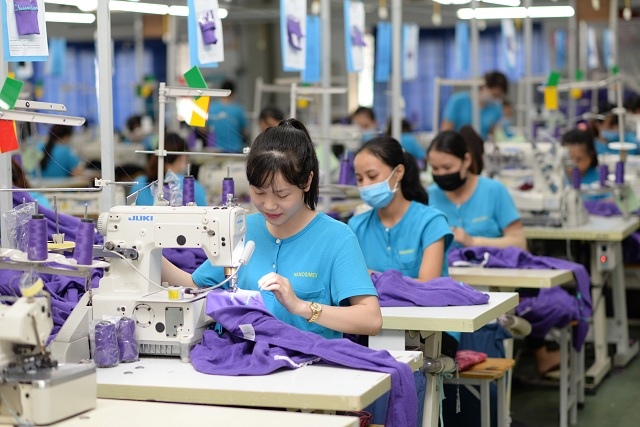VGT gets ahead of the US tariffs
Revenue and profit for the first half of 2025 at Vietnam National Textile and Garment Group (UPCoM: VGT) surged, showing that the company’s strategy to anticipate tariff policies has been effective.

Even so, VGT faces multiple challenges, including raw material supply, exchange rate risks, logistics and labor costs, and interest rates.
Positive business results
In the first six months of this year, VGT’s net revenue reached nearly VND 8.718 trillion, up 10%, while net profit came in at over VND 321 billion, soaring 657% year-on-year. Both revenue and net profit for the period marked the highest levels in the past three years. The company has achieved 48% of its full-year revenue target and nearly 72% of its pre-tax profit target (VND 910 billion).
Despite tariff challenges, VGT led the sector’s growth, followed by Hoa Tho Textile and Garment JSC (HTG) with VND 129 billion in net profit, up 70%—a record quarterly high—thanks to cost controls and higher selling prices.
Hue Textile and Garment JSC (HDM) also posted a record quarterly profit of nearly VND 54 billion, up 80% year-on-year. Other firms also reported record earnings, such as TNG Investment and Trading JSC with VND 120 billion, up 39%, and Song Hong Garment JSC (MSH) with VND 180 billion, up 96%.
The common factor for VGT and these companies is securing raw materials locally instead of importing them, avoiding risks from U.S. tariffs.
In 2025, VGT aims to double consolidated profit for the 2025–2030 period compared to 2024 (about VND 1.7 trillion) and triple after-tax profit (about VND 470 billion).
Tight control over origin of goods
Although results for the first half of the year were strong, the second half will bring volatility, especially from the Trump administration’s tariff policy. VGT must therefore have strategies to adapt to the new landscape.
VGT Chairman Le Tien Truong emphasized: “Although tariffs have been reduced, Vietnam still has no advantage compared to many competitors in the U.S. market. Units need to quickly adjust production appropriately, ensure jobs and incomes for workers, and optimize financial management to maintain competitiveness over the next five months, a period expected to see many fluctuations.”
He also noted that while the U.S. remains a major market, the risk of high tariffs persists—especially given that Vietnam imports up to 65% of its fabric from China, a country subject to strict origin controls.
To continue exporting to the U.S., VGT must classify and clearly identify fabrics that can be sourced domestically, increase local procurement of accessories to prioritize fabric import quotas, work with customers to diversify material supply, and accelerate digital transformation for traceability.
Challenges ahead
To avoid tariffs, VGT proactively purchased materials in Q1 2025 to prepare for the production ramp-up in Q2. This helped control costs and improve margins but also increased inventory pressure. VGT continues to hold the highest inventories in the industry—over VND 3.3 trillion—including VND 1.435 trillion in raw materials (up 28%) and VND 669 billion in finished goods (up 16%).
While U.S. tariffs on Vietnamese textile and garment imports have been reduced to 20% since early August, tariff risks remain for VGT and the sector as a whole. Experts say Vietnam has few competitive advantages over other apparel-exporting countries to the U.S. Meanwhile, some markets such as the EU, Japan, and South Korea show mild recovery, but import demand remains below 2022–2023 levels. Additionally, exchange rate risks, logistics costs, labor expenses, and interest rates continue to be major obstacles for VGT and the industry.
Nevertheless, Q2 2025 demonstrated VGT’s and Vietnam’s textile industry’s ability to adapt quickly. Instead of relying solely on short-term policy windfalls, many companies are pursuing long-term investments in supply chains, product diversification, non-traditional markets, and ESG standard upgrades.
By the end of 2025, VGT and other textile enterprises will face heightened pressure from customers increasing demands for social responsibility and technical standards. Even with abundant orders, failure to meet these requirements could make it difficult to retain clients—particularly in demanding markets such as the U.S. and EU. Experts believe VGT must remain cautious and proactively develop contingency plans as the global market outlook becomes increasingly unpredictable.








